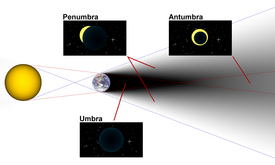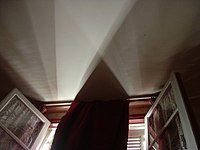Umbra, penumbra and antumbra: Difference between revisions
| Line 10: | Line 10: | ||
== Umbra == |
== Umbra == |
||
[[File:Antumbra.jpg|thumb|200px|right|Umbra, penumbra and antumbra formed through windows and shutters]] |
[[File:Antumbra.jpg|thumb|200px|right|Umbra, penumbra and antumbra formed through windows and shutters]] |
||
The umbra (Latin for "shadow") is the innermost and darkest part of a shadow, where the light source is completely blocked by the occluding body. An observer in the |
The umbra (Latin for "shadow") is the innermost and darkest part of a shadow, where the light source is completely blocked by the occluding body. An observer in the umbraexperiences a total eclipse. The "end" of the umbra is the point where the occulting body is equal in apparent size to the light source; for the Moon, this is roughly the [[semimajor axis]] of its orbit, since the [[angular size]] of the Sun and Moon are nearly identical. Because the Earth is 3.7 times larger than the Moon, its umbra extends correspondingly farther, roughly 1.4 million kilometers.<ref>http://www.astronomy.ohio-state.edu/~pogge/Ast161/Unit2/eclipses.html</ref> |
||
== Penumbra == |
== Penumbra == |
||
Revision as of 16:33, 24 April 2014
This article needs additional citations for verification. (December 2012) |
Error: no context parameter provided. Use {{other uses}} for "other uses" hatnotes. (help).


The umbra, penumbra and antumbra are three distinct parts of a shadow, created by any light source after impinging on an opaque object. For a point source only the umbra is cast.
These names are most often used for the shadows cast by celestial bodies, though they are sometimes used to describe levels of darkness, such as in sunspots.
Umbra

The umbra (Latin for "shadow") is the innermost and darkest part of a shadow, where the light source is completely blocked by the occluding body. An observer in the umbraexperiences a total eclipse. The "end" of the umbra is the point where the occulting body is equal in apparent size to the light source; for the Moon, this is roughly the semimajor axis of its orbit, since the angular size of the Sun and Moon are nearly identical. Because the Earth is 3.7 times larger than the Moon, its umbra extends correspondingly farther, roughly 1.4 million kilometers.[1]
Penumbra
The penumbra (from the Latin paene "almost, nearly" and umbra "shadow") is the region in which only a portion of the light source is obscured by the occluding body. An observer in the penumbra experiences a partial eclipse. An alternative definition is that the penumbra is the region where some or all of the light source is obscured (i.e., the umbra is a subset of the penumbra). For example, NASA's Navigation and Ancillary Information Facility defines that a body in the umbra is also within the penumbra.[2]
In radiation oncology, the penumbra is the space in the periphery of the main target of radiation therapy, and has been defined as the volume receiving between 80% and 20% of isodose.[3]

Antumbra
The antumbra (from Latin ante, 'before') is the region from which the occluding body appears entirely contained within the disc of the light source. An observer in this region experiences an annular eclipse, in which a bright ring is visible around the eclipsing body. If he moves closer to the light source, the apparent size of the occluding body increases until it causes a full umbra.
See also
References
- ^ http://www.astronomy.ohio-state.edu/~pogge/Ast161/Unit2/eclipses.html
- ^ Event Finding Subsystem Preview Navigation and Ancillary Information Facility.
- ^ Page 55 in: T. Hoell; International Symposium on Special Aspects of Radiotherapy 1998 berli; International Symposium on Spe; Hinkelbein, W.; Wiegel, T. (1999). Controversies in Neuro-Oncology: 3rd International Symposium on Special Aspects of Radiotherapy, Berlin, Germany, April 30-May 2, 1998 (Frontiers of Radiation Therapy and Oncology). S. Karger Publishers (USA). ISBN 3-8055-6834-7.
{{cite book}}: CS1 maint: multiple names: authors list (link) CS1 maint: numeric names: authors list (link)
